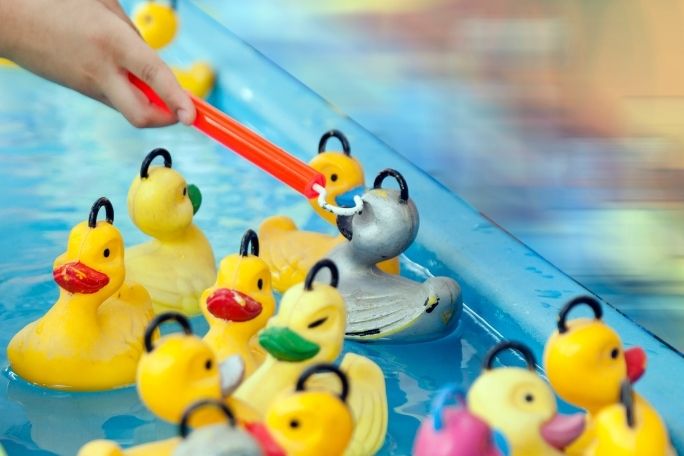Lesson summary
Students will examine the moving or ‘dynamic’ components of the Sustainable STEM Sideshow Game, to estimate the ‘Gravitational Potential Energy’ (GPE) of the moveable components or objects in their game (examples might be balls, bean bags, lollies or sweets, wet sponges…).
Learning intentions:
Students will...
- understand that change to an object’s motion is caused by unbalanced forces, including Earth’s gravitational attraction, acting on the object
- understand that there can be more than one type of energy acting on an object at any one time and that all energy must have been transferred to the object by forces acting upon it
- pose clarifying questions about a simple scientific investigation, measure variables and use equipment to collect and record data
- make hypothetical predictions based on their scientific knowledge.
Success criteria:
Students can...
- explain the concept of ‘Gravitational Potential Energy’ (GPE) in simple terms, giving everyday examples
- explain the concept of ‘Kinetic Energy’ in simple terms, giving everyday examples
- hypothesise what the effect of a combination of GPE and kinetic energy might have on a given object, such as a ball, missile or moving component in a game
- hypothesise what a given change in mass to the moving object, ball, missile, etc. in their Game might have on its trajectory and/or performance.
Lesson guides and printables
Lesson details
Curriculum Mapping
Australian Curriculum content descriptions (v9):
Year 5 to 8 Science:
- investigate and represent balanced and unbalanced forces, including gravitational force, acting on objects, and relate changes in an object’s motion to its mass and the magnitude and direction of forces acting on it (AC9S7U04)
- classify different types of energy as kinetic or potential and investigate energy transfer and transformations in simple systems (AC9S8U05)
- pose investigable questions to identify patterns and test relationships and make reasoned predictions (AC9S6I01)
- plan and conduct reproducible investigations to answer questions and test hypotheses, including identifying variables and assumptions and, as appropriate, recognising and managing risks, considering ethical issues and recognising key considerations regarding heritage sites and artefacts on Country/Place (AC9S7I02)
- write and create texts to communicate ideas and findings for specific purposes and audiences, including selection of language features, using digital tools as appropriate (AC9S6I06)
- develop investigable questions, reasoned predictions and hypotheses to explore scientific models, identify patterns and test relationships (AC9S8I01)
Syllabus outcomes: SC4-10PW, ST3-4WS, SC4-5WS, SC4-4WS
General capabilities: Critical and creative thinking, Numeracy, Literacy
Relevant parts of Year 5 to 8 achievement standards:
By the end of Year 6, students explain how scientific knowledge helps us to solve problems and inform decisions. They follow procedures to develop design investigations into simple cause-and-effect relationships. They identify variables to be changed and measured and describe potential safety risks when planning methods. They collect, organise and interpret their data, identifying where improvements to their methods or research could improve the data.
By the end of Year 8, students identify different forms of energy and describe how energy transfers and transformations cause a change in simple systems. They identify and construct questions and problems that they can investigate scientifically, consider safety and ethics when planning investigations and identify variables to be changed, measured and controlled. Students construct representations of their data to reveal and analyse patterns and trends and use these when justifying their conclusions.
Time required: 50 mins
Level of teacher scaffolding: Medium – Teacher needs to explain various mathematical concepts around probability and assist students to apply the outcomes and event frequencies in their own Sideshow Game to the mathematical conceptual framework around probability.
Resources Required
- a set of ‘nutritional scales’ such as those used to measure weights of food items in grams (these can be purchased quite cheaply at most department stores)
- cardboard tube or concave ramp propped up on a slope, with 3 small balls (see the demonstration in ‘Activating prior knowledge’, as set out below)
- interactive whiteboard or data projector
- students’ ‘Sustainable STEM Sideshow Game’ prototypes, from Lesson 1 of this Unit – set up ready to go in the classroom or learning space
- Student Worksheet for Lesson 3: Gravity and Energy (one per student)
- whiteboard (or electronic whiteboard) with pens.
21st Century Skills
This lesson is designed to build students’ competencies in the following skills:
- communication
- critical thinking
- problem solving.
Additional Info
This is an original Cool+ lesson.


Welcome back!
Don't have an account yet?
Log in with:
By signing up to Cool.org you consent and agree to Cool's privacy policy to
store, manage and process your personal information. To read more, please see
our privacy policy here(Opens in new tab).
Create your free Cool.org account.
Many of our resources are free, with an option to upgrade to Cool+ for premium content.
Already have an account?
Sign up with:
By signing up to Cool.org you consent and agree to Cool's privacy policy to
store, manage and process your personal information. To read more, please see
our privacy policy here(Opens in new tab).